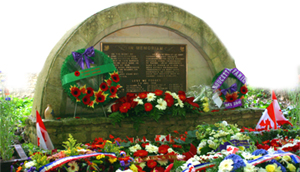Abbaye d'Ardenne

Ardenne Commemorative Plaque (Present Day)
As many as 156 Canadian prisoners of war are believed to have been executed by the 12th SS Panzer Division (the Hitler Youth) in the days and weeks following the D-Day landings. In scattered groups, in various pockets of the Normandy countryside, they were taken aside and shot.
A total of 20 Canadians were executed near Villons-les-Buissons in the Abbaye d'Ardenne, a massive collection of mediaeval buildings -- including an early Gothic church and several farm buildings -- encircled by walls and surrounded by grainfields. This was where Kurt Meyer, Commander of the 25th Panzer Grenadier Regiment (of the 12th Panzer Division), had established his headquarters.
On June 7, the Germans were counter-attacking the Allies in force. The North Nova Scotia Highlanders, supported by tanks from the 27th Canadian Armoured Regiment (The Sherbrooke Fusiliers), were engaged in heavy fighting around Authie. Several of the CAR tanks were disabled and the infantry was overwhelmed. (A street corner in southern Authie was named Place des 37 Canadiens in honour of the 37 Canadians killed there that day.)
The abbey quickly filled with POWs captured during and after the fighting. Ten of them were randomly picked and dispatched to the chateau adjacent to the abbey; the rest were moved to Bretteville-sur-Odon. An 11th POW, Lieutenant Thomas Windsor was brought out to join the group after the first ten men had been selected. That evening, the 11 POWs were taken to the chateau's garden and killed. Several months later, six of the bodies were discovered with crushing blows to the head. Four more were also found afterwards; it was evident they had been shot in the head.
The 11 executed Canadians were:
North Nova Scotia Highlanders
- Private Ivan Crowe
- Private Charles Doucette
- Corporal Joseph MacIntyre
- Private Reginald Keeping
- Private James Moss
27th Canadian Armoured Regiment
- Trooper James Bolt
- Trooper George Gill
- Trooper Thomas Henry
- Trooper Roger Lockhead
- Trooper Harold Philp
- Lieutenant Thomas Windsor
(Bolt, Philp and Lockhead had been members of Lt. Windsor's tank crew on D-Day.)
On June 8, near noon hour, seven more POWs, all of them North Novas who had been fighting around Authie and Buron, were brought to the abbey, interrogated and sent one by one to their deaths. In 10 minutes it was over -- they shook hands with their comrades before being escorted to the garden, where they were each shot in the back of the head with machine pistols. Private Jan Jesionek, a young Polish soldier who had been pressed into service in the Hitler Youth Division, was witness to both the interrogation and shooting, and reported them after the war. As with the others, the remains of this group were not found until the late winter and early spring of 1945.
These Canadian POWs were:
- Private Walter Doherty
- Private Hollis McKeil
- Private Hugh MacDonald
- Private George McNaughton
- Private George Millar
- Private Thomas Mont
- Private Raymond Moore
On June 17 it is believed two more Canadians were executed here -- Lieutenant Fred Williams and Lance-corporal George Pollard, both of the Stormont, Dundas and Glengarry Highlanders. They had been patrolling for disabled German tanks near Buron and went missing. It is known that two wounded Canadian POWs were evacuated by the Germans to the abbey's first-aid post on June 17. Witnesses later reported hearing shots in the vicinity of the abbey at two different times that day.
The Abbaye d'Ardenne was liberated by the Regina Rifles shortly before midnight on July 8. Their members discovered the body of Lt. Williams (who is buried in the Beny-sur-Mer Canadian War Cemetery), however no trace of LCpl. Pollard was ever found. The Bayeux Memorial (near the Bayeux War Cemetery) lists him as missing.
Kurt Meyer was brought to trial for the Abbaye d'Ardenne executions in December 1945 and denied knowledge of them. He was found guilty and sentenced to death -- a sentence later commuted to life imprisonment. He served eight years in a New Brunswick penitentiary and, on September 7, 1954, was released. He died of a heart attack seven years later.
Major (later Colonel) Ian J. Campbell of the Canadian Army was serving in Europe and visited the site in 1980 with members of the Vico family and with Dr. R.L. Bennett, Professor Emeritus at the University of Caen, a Canadian expatriate originally from Winnipeg. The Vico family had lived on the Abbaye grounds since the 1920s (excepting some interruptions in 1944). Noting that there was no tourist literature about the men who had fallen there or the circumstances around the event, Major Campbell undertook to do some research and prepare a small pamphlet, and also to try to arrange for a bronze plaque to mark the historic site. Working with Dr. Bennett and M. Jacques Vico, they decided that a monument might be built using some original stones from the Abbaye recovered and discarded during recent archaeological work at the site so that the monument would be consistent in style with the architecture of the Abbaye. It was proposed to build it on the Vico property right in the park where the murders had taken place. In 1984, Colonel Campbell had a bronze memorial tablet cast in Vancouver and delivered to France for mounting on the monument built by master craftsmen Leon Garnier and Jean Mesnil. Costs were defrayed by donations from Veterans, serving members, relatives and supporters of the project. The monument was unveiled on the Fortieth Anniversary of D-Day, 6 June 1984, by The Hon W. Bennett-Campbell, Minister of Veterans Affairs. The inscription reads:
On the night of June 7/8, 1944, 18 Canadian soldiers were murdered in this garden while being held here as prisoners of war. Two more prisoners died here or nearby on June 17. They are dead but not forgotten.
- Date modified: